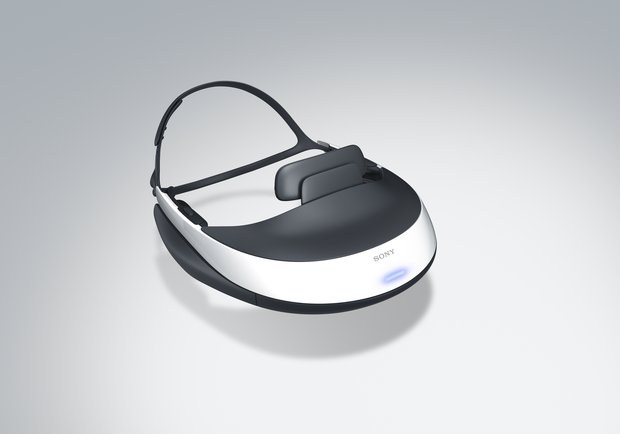Sony reveals 3D HDTV inside a lightweight headset
It's not VR, it's a home theater on your face!
Remember the goofy old days when virtual reality was the future and everyone would soon be wearing goofy visors to control their computers? Why do you think that never panned out? It’s possible that the technology was ahead of its time – the most advanced graphics back then were untextured polygons running at fifteen frames per second. It didn’t exactly make you feel like you were inside some virtual world. The other problem was that the equipment was way, way too bulky to be practical for home use. Sony came by our offices the other day to show us something that looks like one of those old VR headsets, but it’s not trying to go for the virtual gimmick where you turn your head and the camera in-game pans around. No, it’s merely attempting to put a giant HD TV inside a lightweight visor, and we have to say, it looks promising.

Above: What the hell are we looking at? The straps at the left go around the back of your head, the circular things are the headphones, and the pad up top rests on your forehead. You can see the rectangular individual lenses for the eyes inside
It’s called the HMZ-T1, and we got to play some games on this thing for quite a while, so we got a good feel for how it works. While the kit itself looks appropriately goofy and you’d think twice about wearing it in public, it seems to be a legitimate way to game or watch movies, so the one aspect we’re worried about is the price, which we don’t know yet. We’re expecting it to be very expensive, but we’re really hoping it won’t be because if it’s reasonably priced we’re thinking it could be a useful addition to a busy gamer’s leisure time. You’ll see why as we talk about what it does.
First of all, the headset weighs about one pound, so it won’t kill your neck, at least in short periods of use while sitting up. We’re thinking a great way for extended use would be to kick back on a couch or bed with your head propped up by a pillow and you’ll be good to go. The headset has multiple straps for adjusting fit and we found it quite comfortable – it’s designed so that it rests mainly on your forehead and the back of your skull, with no weight on your nose and the visor part sort of floating in front of your eyes. It has built-in headphones with simulated 5.1 surround sound. The kicker, though, is the screen(s).

The visor features two screens – one for each of your eyes. What you see is a type of illusion: it looks like you’re about fifteen feet away from a 150-inch TV. This means that the screen swallows up almost all of your vision but doesn’t feel like it’s jammed in your eyes. In addition, since it’s really two separate screens, the headset can do 3D, and it’s some of the best looking 3D we’ve ever seen. Normally 3D is achieved through a doubling of a single image and then polarized or active shutter lenses selectively allow each eye to see a different image. What this leads to is the familiar flickering or doubling of images, but with individual screens for each eye, the 3D in the HMZ-T1 is near-flawless. We’re not prone to 3D headaches so we can’t be sure how it will affect everyone, but without all the flickering it could make a difference for those who have had issues with 3D in the past.
We first played Gran Turismo 5 and actually wondered if the 3D was even turned on, but realized that GT5’s 3D is extremely subtly designed, and with the lack of flicker the image was invisibly deepened. Once we checked out a movie and played MotorStorm Apocalypse, the 3D became obvious and looked damn good. Overall we enjoyed using the device quite a bit and could see the potential for it in certain households: you could game or watch movies anywhere in your house, including lying in bed next to a significant other while they sleep, without disturbing them. It allows for a giant screen and impressive 3D without the need for such a humongous TV in your home, although of course we need to see the price before we can determine if it’s a cost-effective way of adding a second TV to your household. It could potentially be useful for travel, although it needs its own power plug, so it wouldn’t be easy to bring on a plane without a source for playing a movie or game as well as some type of plug-in battery power, all of which combined would be quite bulky. It would, however, provide a better viewing experience at a hotel than the typical dinky TVs they provide.

Above: The cord sticking out is a power cord - it has to be plugged into an outlet, limiting its portability, but at least you don't have to worry about batteries (imagine how many batteries this thing would suck down)
Weekly digests, tales from the communities you love, and more
The tech is no doubt promising, but there are still questions that need answering: the price, how it holds up comfort-wise over extended use, and if the visual acuity and 3D effects will be suitable for all users. We noticed during our time with it that the edges of the screen were slightly blurry, which affects HUD elements in games. We noticed that even slight adjustments in how the headset sits on your head affects the visual clarity, so it’s possible that a bit more fiddling could produce blur-free edges, but we’re not totally sure. Even with that little bit of blur, the rest of the visual quality was crisp enough that we don’t think we’d mind it over time. What will make or break this piece of fancy tech, though, is the price, which remains a big unknown as of yet.
Aug 31, 2011



